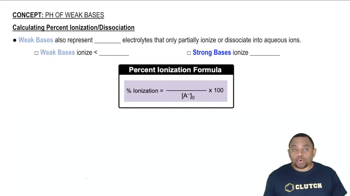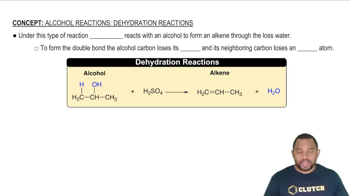Here are the essential concepts you must grasp in order to answer the question correctly.
Ionization of Weak Bases
Weak bases partially ionize in water, meaning they do not completely dissociate into ions. For example, ammonia (NH3) reacts with water to form ammonium (NH4+) and hydroxide ions (OH–). This process is essential for understanding how weak bases contribute to the pH of a solution and the formation of hydroxide ions.
Recommended video:
Calculating Percent Ionization of Weak Bases
Equilibrium Constant (Kb)
The base dissociation constant (Kb) quantifies the strength of a weak base in solution. It is defined as the ratio of the concentration of the products (the ions formed) to the concentration of the reactants (the un-ionized base) at equilibrium. A higher Kb value indicates a stronger weak base, which ionizes more in water.
Recommended video:
Hydrolysis Reaction
Hydrolysis reactions occur when a base reacts with water to produce hydroxide ions. In the context of weak bases, this reaction is crucial for determining the pH of the solution. For example, when bicarbonate (HCO3–) acts as a weak base, it accepts a proton from water, leading to the formation of carbonate (CO3^2–) and hydroxide ions (OH–).
Recommended video:
Alcohol Reactions: Dehydration Reactions

 Verified step by step guidance
Verified step by step guidance


